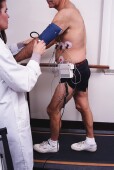
THURSDAY, Sept. 22 (HealthDay News) — A cardiac rehabilitation program appeared to reduce some of the risk factors for a second stroke among patients who have suffered mild strokes or the mini-strokes known as transient ischemic attacks (TIA), researchers have found.
“Overall, following the cardiac rehab intervention, the TIA and mild stroke patients improved significantly in their risk profile,” study senior investigator Neville Suskin, medical director of the London Health Sciences Centre Cardiac Rehabilitation & Secondary Prevention Program in London, Ontario, said in a news release from the American Heart Association.
The investigators looked at 80 of 100 patients who’d had a stroke or TIA in the past year and went on to complete a 7.5-month outpatient cardiac rehabilitation program.
The peak exercise capacity of the patients improved by an average of about one-third, while “bad” LDL cholesterol, triglycerides and total cholesterol fell, the study found. (The changes in “good” HDL and “bad” LDL cholesterol weren’t considered to be statistically significant, the authors noted.)
Also, waist sizes, weight and body mass index (a measurement that takes into account height and weight) dropped on average. So did blood pressure, but at a statistically non-significant amount, according to the report.
“While a TIA or mild stroke may seem small, in reality these events are crucial warning signs of possible catastrophic stroke or heart attack,” study lead author Peter L. Prior, clinical psychologist in the London Health Sciences Centre Cardiac Rehabilitation & Secondary Prevention Program, said in the news release.
“Our study is novel because it shows that cardiac rehabilitation, involving structured programs in exercise, nutrition, smoking cessation and psychological services, is a feasible, potentially effective way for TIA or mild stroke patients to reduce their risk of strokes or heart attacks,” Prior said.
The researchers are conducting a more rigorous study to compare patients who take part in cardiac rehab to those who don’t.
Commenting on the findings, Dr. Michael Katsnelson, an assistant professor of clinical neurology at the University of Miami Miller School of Medicine, cautioned that the study has limitations. “A much bigger, randomized trial needs to be conducted to measure carefully secondary strokes and TIA and compare it to a control group with traditional medical management,” he said.
It’s not clear why some people didn’t finish the cardiac rehabilitation program, he noted, and it’s also not certain that reducing risk factors will reduce the risk of a second stroke. “There may be additional factors that contribute to recurrent stroke that we do not yet understand or target properly,” Katsnelson pointed out.
Still, he said, it’s clear that “there is good evidence that lowering one’s cholesterol, blood pressure and sugar to recommended levels, quitting smoking, a healthy diet and regular exercise” lead to less risk of stroke and cardiovascular disease.
The study findings were released online Sept. 22 in advance of publication in the November print issue of the journal Stroke.
More information
For more about strokes, visit the U.S. National Library of Medicine.

